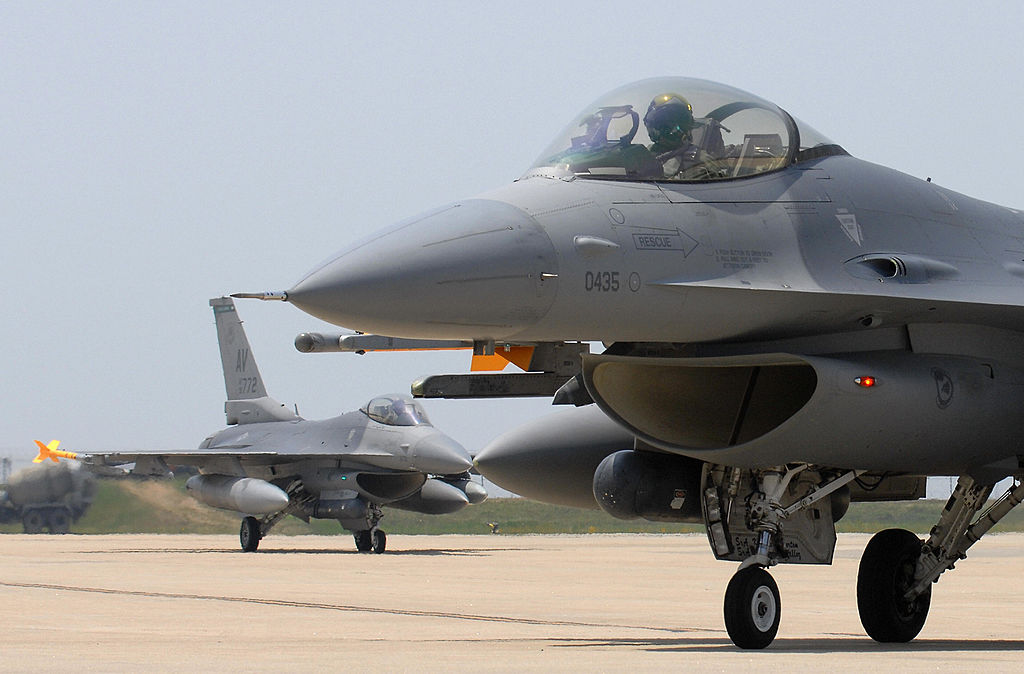
Sea state
The Russian and Chinese navies held a joint patrol exercise last month involving manoeuvres near the US Pacific coast. The ships travelled more than 7,000 nautical miles through the Sea of Japan, Sea of Okhotsk, Bering Sea and Pacific Ocean for over three weeks. China’s Defence Ministry said the exercise was aimed at ‘safeguarding the security of strategic waterways’. American officials noted that the ships didn’t enter US territorial waters.
On 22 August, the coastguards of India and the Philippines signed a memorandum of understanding on maritime cooperation. The main achievement of a five-member Filipino coastguard delegation’s official visit to India, it seeks to enhance professional links between the two coastguards in maritime law enforcement, search and rescue, and pollution response. It was followed by the first-ever bilateral meeting between the maritime agencies of India and the Philippines.
Flight path
The US will begin training Ukrainian pilots on F-16 fighter jets this month to strengthen Ukraine’s air defences and bolster its counteroffensive against Russian forces. The pilots will be trained in Texas and Arizona, with the program consisting of English-language and flight training. According to a Pentagon spokesperson, F-16 training can take around five months for experienced pilots. The announcement builds on plans by Denmark and the Netherlands to donate F-16s to Ukraine and train its pilots.
A US Marine Corps MV-22 Osprey crashed on the Tiwi Islands north of Darwin over the weekend, killing three US service personnel and hospitalising five others. The crash occurred during joint exercise Predators Run, conducted by the militaries of the US, Australia, Indonesia, the Philippines and Timor-Leste. The incident is the latest deadly crash involving an Osprey aircraft, which have been involved in numerous accidents over the years.
Rapid fire
Singapore and China are to resume bilateral military exercises in Singapore following a pandemic-induced hiatus, as confirmed by Singapore’s Ministry of Defence. This renewed collaboration, scheduled for a two-week span starting on 1 September, will focus on urban counterterrorism operations, with soldiers engaging in activities such as hand-to-hand combat and live-firing of small arms. The exercise aligns with the Singapore Army’s commitment to cooperate with foreign military forces and coincides with China’s efforts to strengthen security ties in Southeast Asia.
Australia has deployed a troop of M1A1 Abrams tanks, an infantry platoon, an array of armoured vehicles, and command-and-control posts to the northeast of Java, Indonesia. Exercise Super Garuda Shield, initiated by the Indonesian National Armed Forces and US Indo-Pacific Command, will take place over the next two weeks. It focuses on enhancing collaborative deployment capabilities of significant land forces across the Indo-Pacific region.
Final frontier
The Indian Space Research Organisation’s solar-powered Pragyan rover has been exploring the moon’s south pole for the past eight days, with one more week to go. The Chandrayaan-3 mission has recorded temperature variations in the lunar topsoil, achieving one of its main goals and marking its first scientific results, and the rover navigated its first surface obstacle—a lunar crater. The mission completed India’s bid to become the fourth country to execute a controlled moon landing, after the US, Russia and China, and the first to do so on the moon’s unexplored south pole.
Meanwhile, Russia’s Luna 25 spacecraft, its first moon mission in 47 years, collided with the moon’s surface after it spun into an uncontrolled orbit and lost contact with Roscosmos, Russia’s space agency. This mission was Russia’s attempt to be the first to conduct a controlled landing on the moon’s south pole, competing with India’s Chandrayaan-3. In its wake, analysts have noted that Russia’s space program has been declining for years, with state funding increasingly directed to the military, a pattern likely worsened by Russia’s invasion of Ukraine.
Wired watchtower
A hacking group suspected to be linked to the Chinese government, Flax Typhoon, has been targeting Taiwanese organisations, including government entities, manufacturing firms and technology companies. Microsoft reported that the attacks were likely aimed at maintaining long-term access to the networks of these organisations for espionage. Microsoft’s reports emerged on the same day that the US approved a new arms sale worth US$500 million to Taiwan. Such attacks are likely to increase as tensions over Taiwan continue to escalate and spill over into the cyber domain.
Hackers likely associated with North Korea have targeted a US–South Korea joint military exercise. A joint investigation by South Korean police and the US military has held Pyongyang responsible for the attack. North Korean state media had earlier described exercises between South Korea and partners as rehearsals for invasion that merit ‘overwhelming’ responses. Officials said that no confidential military information was compromised during the hack, which occurred a day after a joint statement was issued by South Korea, Japan and the US that emphasised strengthening trilateral cooperation to counter North Korea’s cyber operations—some of which reportedly pay for its weapons development.

